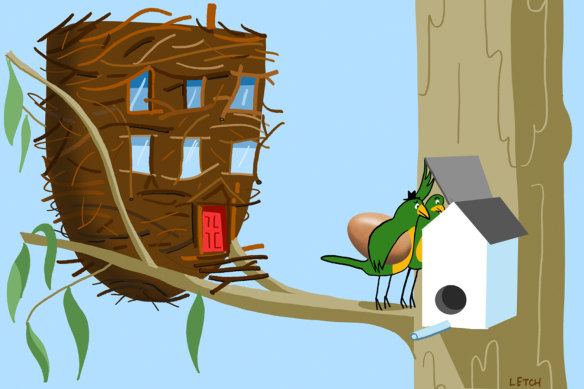How downsizing could boost your super as you approach retirement
Save articles for later
Add articles to your saved list and come back to them any time.
The traditional idea of staying in a family-sized home until we die is finally evolving. With a little nudge from the Government’s enticing downsizer incentive which was boosted this year, forward-thinking pre- and post-retirees are reassessing their homes with fresh optimism, and wondering if they are indeed the keys to bolstering their super balances. And they might well be.
The numbers tell us it’s time. Nearly 60,000 Australians have downsized and poured more than $14.5 billion into their superannuation funds using the downsizer incentive in the last five years according to the ATO. And when they downsize, they not only reap the financial rewards, they also unlock a wealth of potential lifestyle benefits that can come from moving into areas better suited to their looming retirement years.
Is it time to think about downsizing?Credit: Simon Letch
Recent ABS Census data indicates that between 75 and 80 percent of pre-retirees and retirees own their own homes in this country. Yet, the average superannuation balance sits somewhere between $150,000 and $200,000 among people aged 55-74, a figure that falls short of meeting the expectations for a comfortable retirement. And the mean housing price in Australia stands tall, at a formidable $912,000 in the June quarter.
The government recognises the imbalance in these numbers, and they’ve well and truly done what they can with the downsizer incentive to try and correct it.
The downsizer incentive encourages people to sell the family home, provided they have owned it for more than ten years, and invest up to $300,000 per person, or $600,000 per couple into superannuation, tax-free.
It was launched five years ago, but was slow to find appeal. At first, it was available only to people over 65, then, from 2020 to over-60s, and now, on January 1, 2023, they made it more accessible again, dropping the qualifying age to 55, the perfect window for retirement planning. And at 55 I think they’ve found the sweet spot for retirement lifestyle-seekers wanting to rid themselves of the shackles of the big home.
Smaller homes require less maintenance and are more cost-effective to run, but downsizing might also drive a shift to a more suitable lifestyle.
So if you are contemplating downsizing, here’s a few important things you might want to consider:
Understand your timing windows. The downsizer incentive is only available to you after the age of 55. And, even then, it is not available to you unless you’ve owned your home for at least ten years, calculated from the date of settlement.
So timing it will be important for some people. If you can see the window of opportunity a few years ahead of you, keep a watch on the signposts and don’t be tempted to sell early, unless you’ve calculated the opportunity cost.
Think about your pension eligibility. Your principal place of residence is exempt from the age pension assets test. That means you can own a big house in Noosa, and if your other assets are not exceeding the pension limits, you might still qualify for the pension!
If you sell that home and put $600,000 into your superannuation as a couple, on top of a moderate or above-average superannuation balance, you could price yourself out of the age pension altogether. And that might not have been your intention. So do your homework.
Decide how much of your capital you want to reinvest in your next home. Owning your own home, debt free, before you retire is an important part of most people’s retirement plan.
The ASFA Retirement Standard’s definition of a comfortable retirement leans on it as critical to being able to manage your expenses as you age. So you’ll want to make sure you allocate enough of the proceeds of your old house to put towards your next home, before you reap those superannuation benefits.
Consider where you might really benefit from living. The benefits of downsizing reach much further than the direct financial gains. When you downsize by choice in mid-life or later, you often choose a home that brings lifestyle benefits and is more manageable and more cost-effective than the large, traditional family homes we chose earlier as our families were growing.
We all know that smaller homes require less maintenance and are more cost-effective to run. But we might not also recognise that a downsizing move might drive a shift to a more suitable lifestyle location with social and health benefits, and that these in turn can lead to a more fulfilling and enjoyable retirement. So think about where you might really benefit from downsizing to.
Ask a financial advisor. The strategies around downsizing, taking advantage of the downsizer incentive to boost your superannuation, and investing those funds for a solid return are important to get right. You only get one shot at this and you don’t want to mess up your pension eligibility because you didn’t understand the whole picture. Financial advisers will help you dive deeper into the terms and conditions, and they’ll look at your bigger picture with you.
Bec Wilson is author of How to Have an Epic Retirement, which is now available online and in all major booksellers. She writes a weekly email newsletter for pre- and post-retirees at epicretirement.net.
- Advice given in this article is general in nature and not intended to influence readers’ decisions about investing or financial products. They should always seek their own professional advice that takes into account their own personal circumstances before making any financial decisions.
For expert tips on how to save, invest and make the most of your money, delivered to your inbox every Sunday, sign up for our Real Money newsletter here.
Most Viewed in Money
From our partners
Source: Read Full Article
